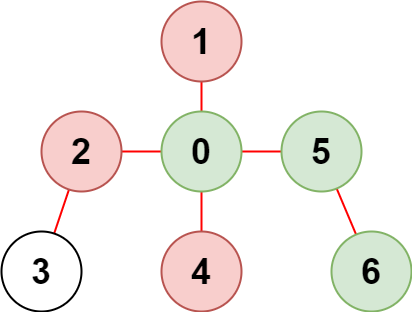目录
2368. 受限条件下可到达节点的数目
题目描述:
实现代码与解析:
DFS
原理思路:
2368. 受限条件下可到达节点的数目
题目描述:
现有一棵由 n 个节点组成的无向树,节点编号从 0 到 n - 1 ,共有 n - 1 条边。
给你一个二维整数数组 edges ,长度为 n - 1 ,其中 edges[i] = [ai, bi] 表示树中节点 ai 和 bi 之间存在一条边。另给你一个整数数组 restricted 表示 受限 节点。
在不访问受限节点的前提下,返回你可以从节点 0 到达的 最多 节点数目。
注意,节点 0 不 会标记为受限节点。
示例 1:

输入:n = 7, edges = [[0,1],[1,2],[3,1],[4,0],[0,5],[5,6]], restricted = [4,5] 输出:4 解释:上图所示正是这棵树。 在不访问受限节点的前提下,只有节点 [0,1,2,3] 可以从节点 0 到达。
示例 2:

输入:n = 7, edges = [[0,1],[0,2],[0,5],[0,4],[3,2],[6,5]], restricted = [4,2,1] 输出:3 解释:上图所示正是这棵树。 在不访问受限节点的前提下,只有节点 [0,5,6] 可以从节点 0 到达。
提示:
2 <= n <= 105edges.length == n - 1edges[i].length == 20 <= ai, bi < nai != biedges表示一棵有效的树1 <= restricted.length < n1 <= restricted[i] < nrestricted中的所有值 互不相同
实现代码与解析:
DFS
class Solution {public final int N = (int)2e5 + 10;// 邻接表int[] h = new int[N], e = new int[N * 2], ne = new int[N * 2];int idx;// 连边方法public void add(int a, int b) {e[idx] = b; ne[idx] = h[a]; h[a] = idx++;} public int reachableNodes(int n, int[][] edges, int[] restricted) {Arrays.fill(h, -1); // 别忘了// 构成邻接表for (int[] e: edges) {int a = e[0];int b = e[1];add(a, b);add(b, a);}// set记录被标记的节点Set<Integer> set = new HashSet<>();for (int t: restricted) {set.add(t);}// 从0节点dfs遍历int res = dfs(0, -1, set);return res;}public int dfs(int cur, int f, Set<Integer> set) {int count = 0;for (int i = h[cur]; i != -1; i = ne[i]) {int j = e[i];if (j != f && !set.contains(j)) {count += dfs(j, cur, set);}}count++;return count;}
}原理思路:
简单的dfs,从0开始遍历即可,统计可以走到的节点的个数。set用于记录受限制的节点,作为递归条件。




)
)
--树形DP没有上司的舞会)


)





)



